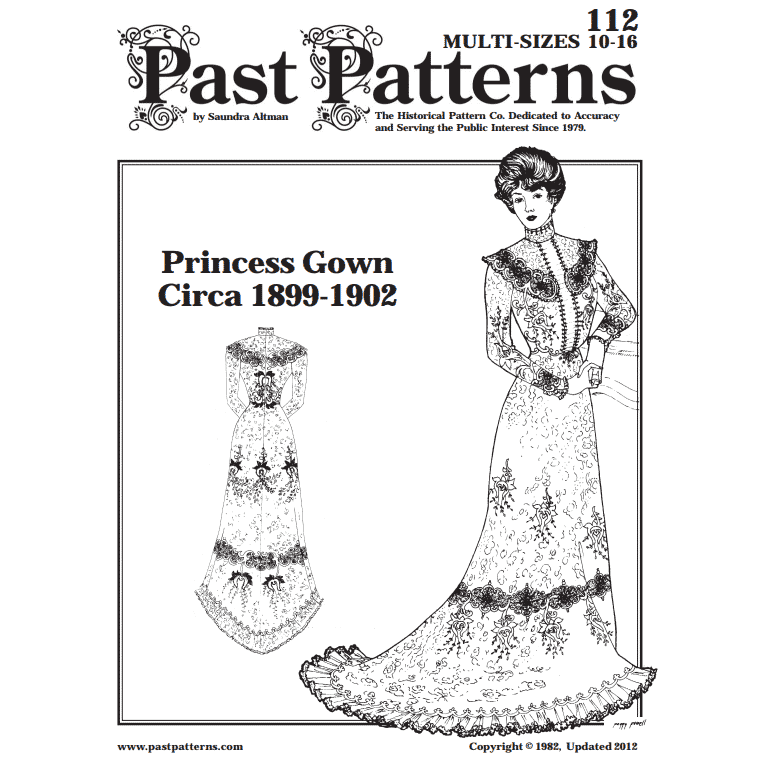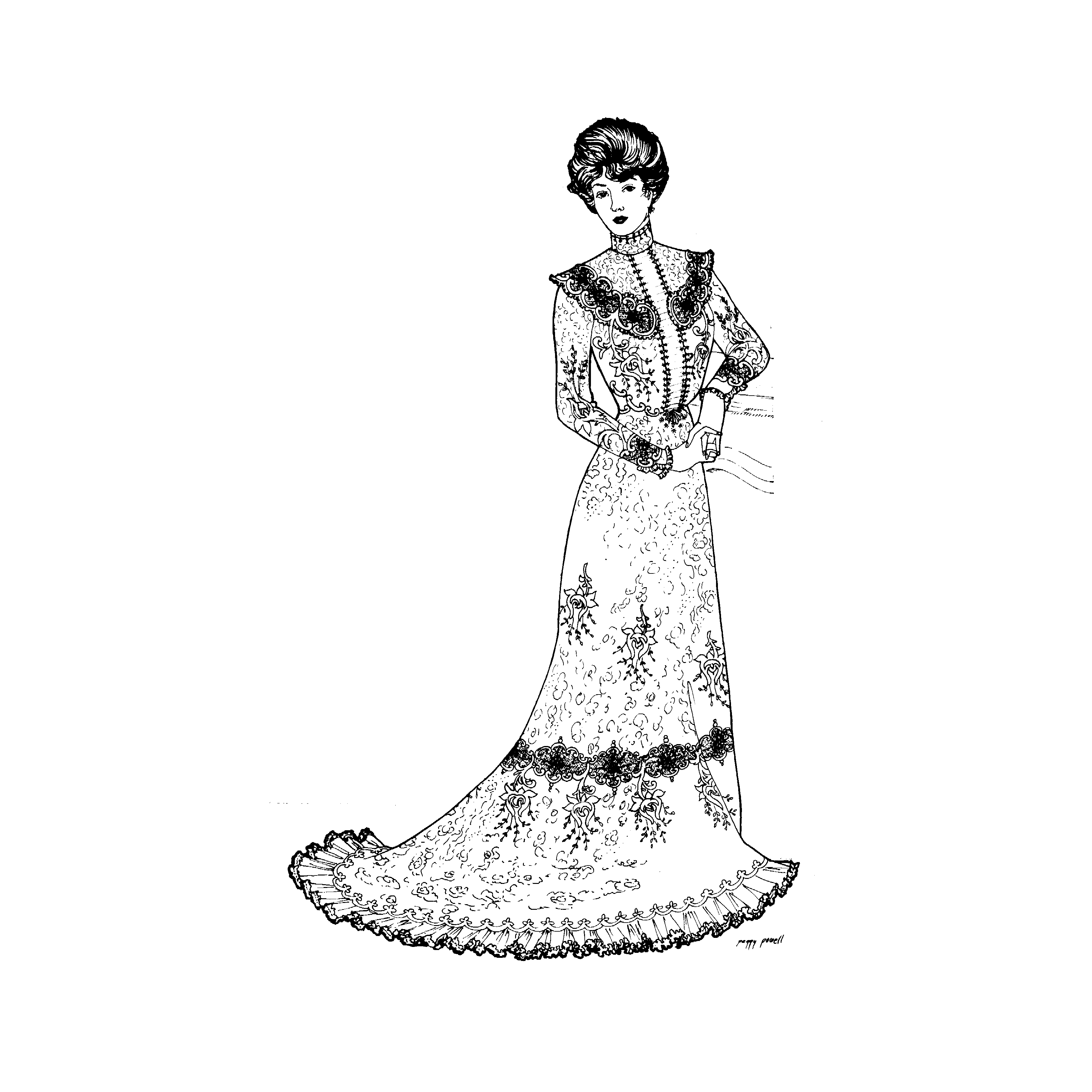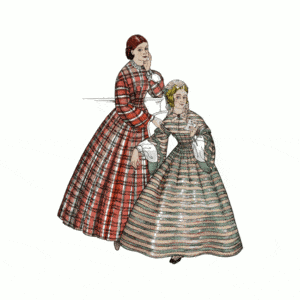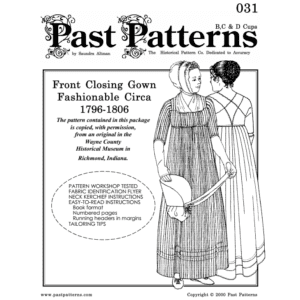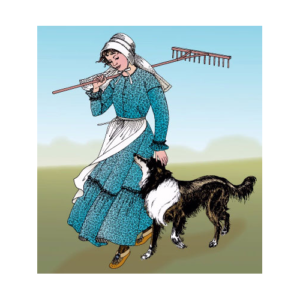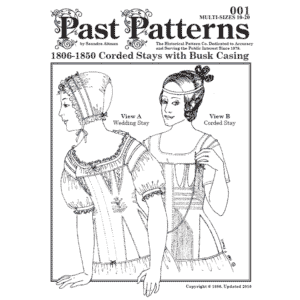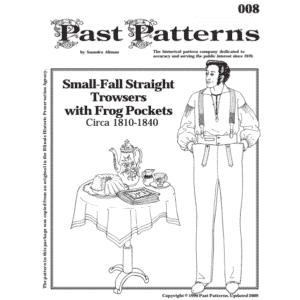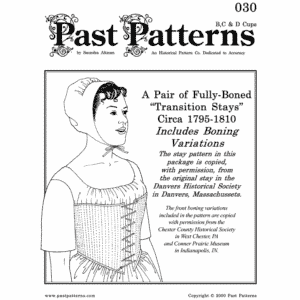Edwardian Reception Gown Sewing Pattern | Past Patterns 0112
$25.00
Recreate Edwardian elegance with this meticulously researched reception gown pattern (1899-1902). Features princess cut design, lace overlay, and detailed embellishments.
Get Free Shipping
On all US Orders over $50!
$25.00
Recreate Edwardian elegance with this meticulously researched reception gown pattern (1899-1902). Features princess cut design, lace overlay, and detailed embellishments.
Get Free Shipping
On all US Orders over $50!
All of our patterns tell a story.
Why Choose This Pattern?
Edwardian Reception Gown Sewing Pattern - Elegant Turn-of-the-Century Design
The Edwardian Reception Gown pattern from Past Patterns showcases the quintessential silhouette of high society during the early 1900s. This exquisite dress captures the refined elegance that defined the Edwardian era (1899-1902), featuring the distinctive princess cut that creates a smooth, flowing line from shoulder to hem. Each Edwardian Reception Gown is a masterpiece of historical tailoring, meticulously researched and documented to provide you with a museum-quality reproduction.
Historical Background of the Edwardian Reception Gown
The Edwardian Reception Gown represents the transitional period between Victorian excess and the streamlined silhouettes that would later emerge. During this period, formal reception gowns were essential for ladies of society attending afternoon gatherings, tea parties, and evening soirées. This style of gown, with its high neckline, fitted bodice, and sweeping skirt, epitomizes the grace and sophistication of Edwardian fashion sensibilities. The Princess line construction featured in this reception gown pattern was particularly favored for its ability to create an elongated, statuesque silhouette without the bulky understructures of previous decades.
Fashion historians have noted that gowns of this style were frequently featured in publications like "The Ladies' Home Journal" and "Harper's Bazaar" between 1899-1902. Similar examples can be found in the Metropolitan Museum of Art's costume collection, showcasing the cultural significance of these garments.
Features of Our Edwardian Reception Gown Sewing Pattern
The construction of the Past Patterns princess cut reception gown is deceivingly simple in its foundational structure. What elevates this Edwardian Reception Gown pattern to a true work of art is the extensive decoration that transforms the silhouette:
- Valencienne lace overlay encrusted with heavy needlework lace below the knees
- Elaborate silk embroidery and appliques at the waist, sleeves, and skirt
- Delicate organza trim adorning the neck, wrist, and hem
- Back closure with traditional hooks and eyes
- Skirt hem finished with several rows of ruffles for fullness and movement
This Edwardian Reception Gown pattern includes comprehensive instructions for creating both the foundation garment and the decorated overlay, allowing you to recreate this historical masterpiece with precision and confidence.
Pattern Specifications
Our Edwardian Reception Gown pattern comes in multiple sizes to ensure a proper fit:
- Size 10: Bust 33" | Waist 25½" | Back Length 15¾"
- Size 12: Bust 34¾" | Waist 27" | Back Length 16"
- Size 14: Bust 36¼" | Waist 28½" | Back Length 16⅛"
- Size 16: Bust 37¾" | Waist 30¼" | Back Length 16⅜"
Fabric and Notions Requirements
To create your Edwardian Reception Gown, you will need:
Foundation/Petticoat Fabric: Bottom Weight Silk Taffeta
- Sizes 10-12: 5⅓ yards
- Size 14: 5½ yards
- Size 16: 5⅔ yards
Overlay Fabric Suggestion: The original overlay fabric was a black nubby plain weave, medium weight wool. We recommend waiting until you receive the pattern before purchasing the lace overlay, organza, and trims to ensure correct quantities.
Notions:
- 6 yards of 3½" wide trim lace for all sizes
- 11¼ yards of ½" wide double faced satin ribbon trim
- 5 yards piped braid for street hem
- Three 3" zig-zags for collar
- 1 yard ¾" double edge crochet
- Four 6" x ¼" white steel stays
For Appliques:
- 2 yards taffeta
- 2 yards press-on interfacing
- 16 yards or 8 packages of ⅛" or 1/16" soutache braid in the same color as taffeta
- 6 yards ½" wide double faced silk satin ribbon for applique
- 2½ yards 4" wide heavy lace such as cluny or crocheted
- 3/16" loosely twisted silk floss or a creative substitute (something curly)
Skill Level Required
The Edwardian Reception Gown sewing pattern is recommended for intermediate to advanced sewists. While the basic construction techniques are straightforward, this project requires precision in the following areas:
- Detailed hand-sewing for applying lace and trims
- Experience with French seams and other fine finishing techniques
- Patience and precision for the elaborate decoration elements
- Total of 15 pattern pieces requiring careful assembly
- Knowledge of proper fitting techniques for historical garments
The time investment for this project is substantial, but the resulting Edwardian Reception Gown will be a showstopping reproduction worthy of display or special historical events.
What's Included in Your Pattern Package
Your Edwardian Reception Gown sewing pattern package includes:
- Original artwork on the front cover
- Sizing chart and fabric suggestions on the back cover
- Notes on Fine Points when sewing garments
- Information on altering pattern pieces and measuring accurately
- Fabric layout chart
- Explicit construction notes
- Extensive written and illustrated tutorial for building the gown
- Computer-printed patterns on 4 sheets (36"x54", 36"x58", 36"x59", and 36"x57")
All patterns are printed on 20 lb. white paper and packaged in a reusable plastic sleeve. We always attempt to offer the most reasonable shipping rates for domestic and international orders. Multi-item purchases are automatically adjusted for combined shipping.
Prefer a digital download? Get this pattern in our downloadable format here.
Create a breathtaking historical recreation with this meticulous Edwardian Reception Gown pattern - a timeless design that embodies the elegance and refinement of early 20th century fashion.
Original Content by Past Patterns 1979-2025. All rights reserved.
Additional information
| Weight | 18 oz |
|---|---|
| Dimensions | 13 × 10 × 3 in |
This item is for single, non-commerical usage. If you want to mass produce items, please contact us.
Sizing Information
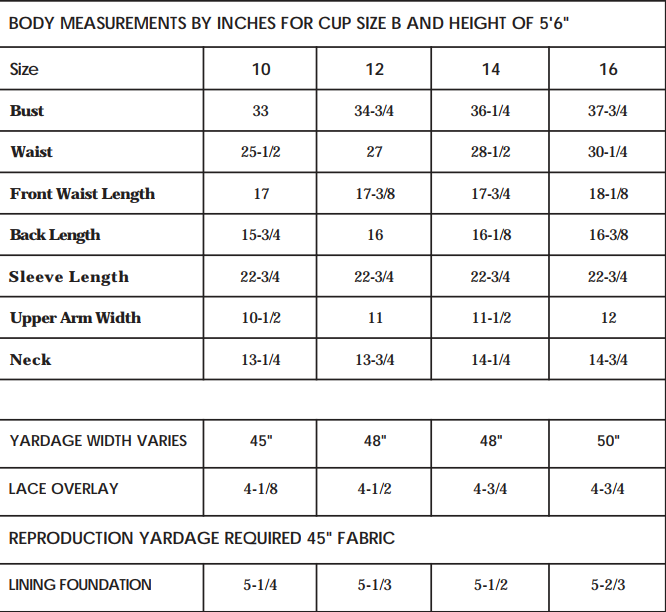
(Metric size sheet opens as a PDF in a new browser tab)
Preferred Vendors
Past Patterns works with vendors from all over the world to help us replicate the amazing articles of clothing. Now you can too!
Visit our preferred vendors page to order directly from some of our top recommended suppliers.
FAQ's
(Frequently asked questions)
Why are both Trowsers and Trousers listed on site?
Over the last 200 years, much like the human body, our style of language has changed. For vintage patterns, we attempt to use the language of the day where possible.
Can you grade (edit) a Vintage Revival pattern for my size?
please contact us with the specific pattern number and the specifications you require. We have staff available for this for an additional fee.
What sizes do Past Patterns patterns come in?
Our patterns, with some exceptions, are manufactured in sizes 8 through 26 for women and sizes 34 through 54 for men. Most patterns are multi-sized. For a complete listing of measurements in inches see the size chart.
Do you have vintage patterns (manufactured prior to 1950) that you want to sell?
we are always on the lookout for original, American designed, vintage patterns especially for categories outside of current items. We are interested if you have 1 pattern or 1000 patterns. Give us a call to discuss.
Why is my pattern size different from my off the rack dress size?
We use the U. S. Board of Standard Measurements to size our patterns. The ready made clothing manufacturers have their own set of sizes developed from their own statistics. For a complete listing of measurements in inches see the size chart.
How are the patterns packaged?
We package our patterns in two forms: Bond Paper and Tissue. Except for the Tissue patterns, each is slipped into a reusable plastic sleeve. Many contain documentation in the form of Historical Notes or the printer ie., Butterick. Because the patterns are printed in house to order, they can take from three to seven days. Tissue patterns, which are printed out of house, are available to ship immediately.
What does a Corset Kit contain in addition to the Corset pattern?
In addition to the pattern, the kits contain everything you need to make the corset except the thread. The kits contain, according to their type, fabric and lining, stays, clasp or busk board, back lacing, tape for finishing the edges, trim lace, ribbon, leather, tin stock, waist tape, punch and setter, eyelets, marking pencils, cording, reed and a loop turner.
Need a pattern in your language?
we can translate our instructions into just about any language
Have an old and incomplete Past Patterns item. What can I do?
The answer depends on if the pattern is still in production or not. If it is, please mail us the old pattern and we will ship you a copy of the latest pattern for a minimal fee along with normal shipping charges. If the item is no longer in production, we would need to know exactly what you have to determine the best course of action to help you.
What is the difference between a Past Patterns original pattern and a Vintage Revival pattern?
The Past Patterns originals were designed in house and based upon the research, disassembly and time of Saundra Ros Altman. These designs come from finds all over the United States reaching from San Diego, California to the Smithsonian Museum in Washington, DC. She created the initial patterns, the sizing charts and the instruction content. Many of the these patterns are multi-sized or are available in various sizes. For the most part, these designs are done taking into account the modern human body's shape, height and weight. The Vintage Revival patterns are traces or copies of an old, mass produced pattern; the first mass produced patterns came out in the 1850s. For the most part, you get exactly what came in the original package; in some cases, Saundra has appended historical notes to the instructions. The Vintage Revivals patterns, being copies of the originals, generally only come in one size and are based upon the size and shape of the human body from the era the pattern came from.
What software do you use to create patterns?
We utilize PW Studio for our designs. Isabelle Lott, a contributor over the years to Past Patterns, is the owner of the company and will be happy to answer an software related questions you have. Her software is available for licensing.
What measurements do I need to know to order a Corset Kit?
The bust and back length. The back length is measured from the prominent bone at the base of the neck to the natural waistline.
Where can I see the appropriate clothing fabrics for the 18th and 19th centuries?
You can see 1740 through 1940 fabrics in a book titled "Textile Designs" by Susan Meller and Joost Elffers. The subtitle states, "Two Hundred Years of European and American Patterns for Printed Fabric by Motif, Style, Color, Layout and Period and 1,823 Illustration in Color." What they don't say is that 90% of the swatches pictured are life size. The ISBN is 0-8109-3853-7. A second book is Wearable Prints, 1740-1860, History, Materials, and Mechanics by Susan W. Greene. The ISBN is 978-1-60635-124-6. Great books! Order it from your local library that has interlibrary loan capability if you cannot afford the price. There are now many sources for appropriate fabric through the Internet.
Where can I find antique patterns to purchase?
On the Internet try: "Patterns from the Past."
Need a pattern tomorrow?
we do offer expedited domestic shipping for extra fees. We can also expeditie international shipments but delivery dates overseas cannot be promised.
Becoming a Wholesalers of our patterns
We offer Wholesalers significant discounts that will allow both your and our businesses to flourish.
Why don't we sell PDFs of our patterns - First due to piracy. We have spent over 40 years creating and tracing these patterns along with researching them. We print and ship all of our patterns ourselves. If we started sending out PDFs, in no time, copies of our Intellectual Property would be all over the internet and we would be out of business. Second, some of our patterns are constantly being updated. We want our clients to get the BEST POSSIBLE version of our products.

